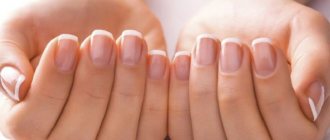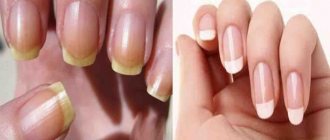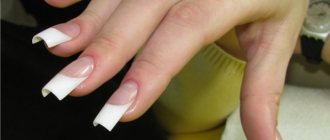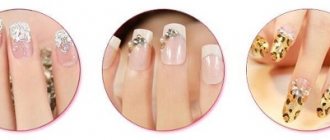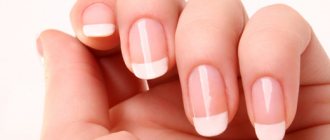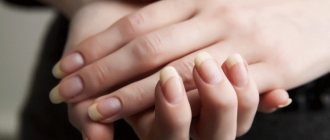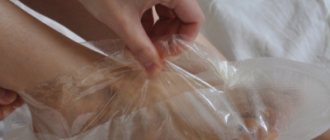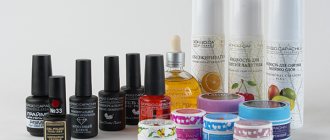» Beauty » Nail care » Nail baths with salt and iodine
0
329
Article rating
At any time of the year, our nails need additional nourishment, and a nail bath with salt and iodine is the best remedy. You probably noticed that after your stay at sea, your nail plates become stronger: they don’t peel, don’t break, and look really healthy. The reasons for this are salt and iodine, which are present in abundance in sea water. Today we will learn how to make iodine and salt baths at home.
Recipe for baths
For a wonderful salt bath with iodine we will need:
- sea salt - if you don’t have it, then take table salt;
- iodine, you only need 3-4 drops;
- pure water;
- a deep container in which it is convenient to immerse marigolds;
- napkin.
So, take water, heat it slightly. Add salt to the liquid, stir until it is partially dissolved, drop 3-4 drops of iodine into the salt bath.
Now you need to sit down more comfortably, place a napkin under the container with the bath, and immerse your marigolds in the water. Take a salt bath with iodine for 10 to 30 minutes, after which you wash your hands and lubricate them with rich cream.
By the way, the same bath can be done for toenails. Be careful, if there are hangnails or scratches on the skin, the salt will sting them.
Choosing salt: which is best?
To make the bath beneficial for your nails, choose the salt that suits you best. The following types of salt are usually used in cosmetology:
- Marine. Contains elements necessary for nail growth and strengthening: calcium, fluorine, selenium, iodine, magnesium. They make the plates strong, durable, and protect against fungus.
- Himalayan. It even surpasses sea water in its beneficial properties. It contains the same elements, and in addition to them - potassium and iron. It is due to the high iron content that Himalayan salt has a pink color.
- English (magnesia). It is an aqueous form of magnesium sulfate. Saturates the skin of the hands and nails with magnesium, partially penetrates the bloodstream, improving the health of the nervous system and improving sleep. With a lack of magnesium in the diet, the nail plates begin to delaminate and break. Magnesia replenishes magnesium deficiency and eliminates brittle nails.
If you don’t have sea salt, Himalayan salt, or Epsom salt in your house, and you need to improve the health of your nails right now, just take table salt. Iodized is also suitable. With its help you will achieve a smaller but sufficient effect to improve the condition of your nails.
Cooking options
Make the simplest strengthening mixture of salt and a glass of water. The procedure lasts from 10 to 20 minutes.
Are your nails fragile and often break? Iodine baths will come to your aid. Making them is simple: 2 tbsp. l. table salt, 3 drops of iodine, ½ cup each of water and soda. Mix everything and keep your fingers in the liquid for 20 minutes.
If nails are in poor condition, they are treated with iodine and olive oil.
Warm 1/3 cup of oil to room temperature and add 3 drops of 5% iodine. The procedure takes up to 25 minutes, after which the nails are washed well with warm water. Replace iodine 2 tbsp. l. sea salt and get a remedy for the treatment of bumpy marigolds.
Depending on the type of nail problems, the following components are added to the bath:
- for the treatment of fragile and flaky skin – lemon, sandalwood, bergamot;
- to improve strength - lemon, eucalyptus;
- for shine and polishing - bergamot and lavender, orange and grapefruit;
- Rosemary, tea tree or chamomile will have an anti-inflammatory effect.
For one procedure, 1-3 drops of essential oil are enough.
How to make a nail bath with salt
First, decide on the effect you want. What do you want to fix in your nails? Strengthen, cure fungus, accelerate growth? The choice of the bath recipe that you will find in this article depends on this. Choose a recipe with the desired effect for you and start preparing the bath.
Regardless of the quantity and type of ingredients, salt baths for hands are prepared and taken as follows:
- Pour warm water into a container (a special manicure bath or a regular bowl). Its temperature should be comfortable for the hands (+37…+38 oC). There is no need for too hot water - it will dry out the skin.
- Dissolve salt in water - table, sea, Himalayan or Epsom salt, depending on the recipe you choose, in the amount necessary to achieve the desired effect.
- Add other ingredients if desired. Consider proportions. For example, if you need to take 4 drops of essential oil per 200 ml of water, and you have 400 ml in the bath, then twice as much essential oil (8 drops) should be added.
- Place your hands in the bath and hold them for 10-15 minutes.
Salt can make your skin drier. To prevent this from happening, after taking a bath, your hands should be rinsed with fresh water, dried with a towel and spread with nourishing cream. It can be replaced with another nutritional mixture of 5 ml of any vegetable oil mixed with two drops of sandalwood essential oil. Applying this oil mixture will provide additional strengthening to your nails.
For medicinal purposes, salt baths for nails should be carried out in courses of 2 weeks. You need to take a break between courses - optimally from 7 to 10 days. It is advisable to repeat the course once a month. A sufficient frequency of procedures to prevent problems is once a week.
Attention! Before the procedure, it is important to remove the varnish coating from the nail plates. Otherwise, the effect will be minimal, and the varnish itself will quickly begin to flake and lose its former beauty.
The benefits and harms of iodine for nails
Iodine is usually used as an additional ingredient to strengthen nails. It can be applied to the nail plate, but after such a mask, the tips of the fingers and nails acquire an ugly yellow-orange tint.
Iodine strengthens but also dries the nail plate. If you simply apply it with a brush regularly, your manicure can be seriously ruined.
A nail bath with iodine works best. Orange or lemon juice, olive oil and, of course, sea salt are added to it. The procedure is done in a 10-time course every other day, after which citrus juice and cream are applied to the nails for a week.
The benefits of baths and the choice of the main ingredient - is it better from the sea or from the kitchen?
For nails, it is recommended to use sea salt baths. It is this that is considered the best remedy in the fight against their fragility, fragility and delamination. This type of salt is obtained by ordinary natural evaporation, so it retains all the components.
Sea salt contains much more iodine than regular table salt. Despite the fact that there is also iodized salt, which is superior in this indicator, sea salt contains a number of other useful components that have a beneficial effect on nails:
- calcium is one of the basic elements for the beauty and strength of nails;
- fluoride – makes it possible to cope with the problem of concave, too thin and uneven nails;
- iodine – strengthens and heals nails;
- selenium - makes them smooth and shiny;
- magnesium – helps cope with dryness and brittleness.
Sea salt is a universal remedy for solving a number of problems. It has a rich composition, which includes almost half of the minerals from the periodic table. All these components improve the condition of the nails, allowing you to forget about the problem of dryness, brittleness and thinning of the nail plate.
Micro- and macroelements have a strengthening, protective, healing effect. Also, the substances in the composition improve nail growth, moisturize the skin of the hands and cuticles.
In order for the baths to give the desired result, it is important to choose the right salt for their preparation. Here are some points to consider:
- Crystal shape and color . The natural product has a uniform structure and crystals of the same shape. If you see an uneven shade of salt and clumps through the packaging, it is better not to buy it.
- Compound . It is better that it does not contain dyes, artificial impurities and other additives.
- Smell . It shouldn't be too harsh. Natural salt has a pleasant and subtle product.
- Place of purchase . It is best to buy salt at a pharmacy or order it from specialized stores.
- Package . High-quality mineralized salt is usually hermetically sealed in jars or plastic bags. The package may also contain a small cardboard box with an insert.
- Origin . The highest quality salt is considered to be from the Dead Sea, which is produced in Israel and other countries of the Middle East. The place where the salt was obtained must be indicated on the packaging.
Reference . On the market you can find salt with various additives of natural origin, such as mint or valerian. Such products are more likely intended for the body, but the components in their composition can have a positive effect on the nail plate.
Many people are interested in whether it is possible to use simple table salt instead of sea salt. The concentration of active components in it is not as high as in sea water, and accordingly, the effect will be weaker. But in the absence of sea salt, you can replace it with regular salt for prevention and easy strengthening of nails. If your nails are too brittle and weak or you use baths for medicinal purposes, it is still better to purchase sea salt.
The benefits and harms of sea salt
Sea salt is a storehouse of vitamins and minerals that nourish our nails during the strengthening procedure.
Salt also nourishes the cells, makes nails dense but elastic, and accelerates their growth.
When doing a cosmetic procedure with sea salt, it is almost impossible to harm your nails. If the dose of salt is exceeded, you can get irritation of the skin of your hands: itching, redness, peeling.
Salt can be used as a separate cosmetic ingredient.
What are the benefits of salt?
1. Salt contains a unique complex of elements beneficial for nails and the body as a whole. Such a bath will saturate the nail plate with bromine, iodine, iron, chromium, etc.
2. A salt bath for the hands can relieve swelling.
3. Substances contained in salt help relieve joint inflammation.
4. Improves blood circulation, which promotes nail growth.
Thus, salt not only strengthens the nail, but also heals the hand as a whole. Because of all the healing properties of salt, it is used not only for nails, but also for a bath for the whole body.
Reviews and results
Homemade cosmetics and analogues of salon procedures are in great demand nowadays. Salt baths for nails are simply a salvation, and the cost of the procedure is no more than 50 rubles.
Reviews of such baths are positive, but users claim that this product nourishes best if you add lemon to it. Be prepared for the fact that a sea salt nail bath is a slow-acting remedy. The effect will be noticeable after 4-5 procedures.
Baths with salt, iodine, lemon juice or oil are a spa resort for your nails.
They are used for prevention and treatment after the extension procedure. If you regularly paint your nails with polish or use nail polish remover, then you know how destructive it is to your nails.
Do not wait until the nails begin to peel and break, but use salt and iodine. After 10-20 procedures, you will not recognize your improved manicure.
Contraindications
Contraindications to the use of sea salt include:
- cuts, wounds on the hands and fingers;
- skin diseases (rash, lichen, dermatitis);
- tendency to allergic reactions of the body to individual components of the product.
Sea salt can corrode fresh wounds and cuts and cause discomfort during the procedure. Otherwise there are no contraindications.
Take a closer look at your nails
Healthy nail plates are slightly transparent, pale pink, smooth and slightly shiny. Their base is a white or pale pink lunula, and the free-growing ends are ivory. The surface should be smooth, without bumps or depressions. The porous structure allows substances to be absorbed, so you can strengthen your nails using baths or masks.
Attention! Any changes in the appearance of the nail plates are a reason to consult a specialist.
- Fragility, layering and slow growth are signs of a lack of vitamins and microelements (primarily A, E, group B, calcium, iron, zinc). Diabetes mellitus and thyroid problems can also manifest themselves.
- The surface is no longer smooth. If transverse grooves appear, this is a sign of damage to the growth zone (matrix). A strict diet, injury, intoxication, fungal infection is the main list of reasons. Many protruding longitudinal grooves are considered a sign of vitamin deficiency, the result of rough manicure or diseases of the digestive system. Pinpoint depressions (like a thimble) are most often a symptom of psoriasis and eczema.
- White spots (stripes) are the result of any chronic illness, injury, poor nutrition, infection or severe stress. The formation mechanism is directly related to the accumulation of air bubbles between the layers of the plate.
- Changing the size of the lunula. Usually the hole takes up a third of the nail. If it is barely noticeable, this is a characteristic sign of anemia. Large lunulae occur in diseases of the cardiovascular system, heavy physical work, and also in athletes.
- If the nail plate has changed color, it’s time to visit a doctor! A bluish color indicates a lack of oxygen due to anemia or circulatory failure. Yellowness indicates a lack of vitamin D, liver problems or the use of low-quality varnishes. The appearance of white color is a sign of vitamin deficiency, fungus, diseases of the cardiovascular or endocrine system. Sometimes this is how allergies manifest themselves. A longitudinal black stripe may appear after an injury when the matrix was affected. Another reason is the development of melanoma (malignant skin tumor).
- A change in shape, when nails become like watch glasses and fingers look like drumsticks, occurs with severe pulmonary or cardiovascular pathology. A spoon-shaped nail plate with a concave center is formed due to iron deficiency and endocrine disorders.

